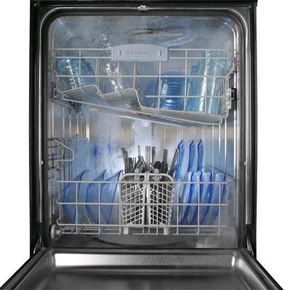The Dirt on Steam Cleaning Dishwasher Technology
Aside from its ability to produce electricity, steam also is a potent cleaning tool. If you've ever steam-cleaned your carpets, you know how powerful it can be compared with vacuuming. Using the same principles, steam dishwashers use high-pressure, high-temperature steam to help separate food from dishes, cups and flatware. The pressure of a gas indicates how much force it exerts on surfaces. The tighter gas molecules are packed together or the hotter they are, the harder they hit surfaces.
To understand why steam is so effective, let's take a look at some of its special properties:
Advertisement
- Steam can contain a lot of heat: Have you ever hungrily peeled off the cover of food that's been heated in the microwave, only to be burned by the steam that rushes out? If you have, you know that steam can get very hot -- even hotter than water. At normal atmospheric pressures, water can only get as hot as about 212 degrees Fahrenheit (100 degrees Celsius). At that point, it turns to steam. The steam, in turn, can carry a lot of heat and, if pressurized, can continue to heat up, which enables it to sanitize objects.
- Steam expands to a bigger volume than water: As water heats up and turns to steam, it can expand and take up more space than the water did. This fact means that a little bit of water can create a lot of steam -- and conduct a lot of cleaning work. In the end, you've used less water to get the same (or possibly better) work done.
- Steam is easily accessible: Because you find "water, water everywhere," you can find the potential for steam everywhere. Just heat water to a high enough temperature and you'll create steam. Steam cleaning doesn't require harmful or expensive cleaning chemicals or detergent to work.
In dishwashers, the high pressure and temperature of steam effectively loosen the strong bonds between muck and your dishes. In this way, steam can break the bonds that even good old-fashioned soap and water couldn't divide. In essence, the food absorbs the steam, which in turn rehydrates the dried, baked-on food so that it releases its death grip on the dish. After breaking the waste down, a good rinse will wash it all away. Perhaps most important, though, is that the extremely high temperatures of the steam also kill bacteria and sanitize the dishes.
Because it has sterilizing power, people use steam for a variety of cleaning purposes. For instance, because it can be gentle yet effective, steam is used to clean masonry surfaces like brick and stone. Some people use steam to clean and prepare surfaces to be painted. And, food processing plants that need to clean their equipment will apply steam to rid the instruments of oils and grease. Public city cleaners can even use steam to remove gum from tables and hand rails [source: Sioux Corporation].
On the next page, we'll learn about the steam dishwasher's steam cycle.
